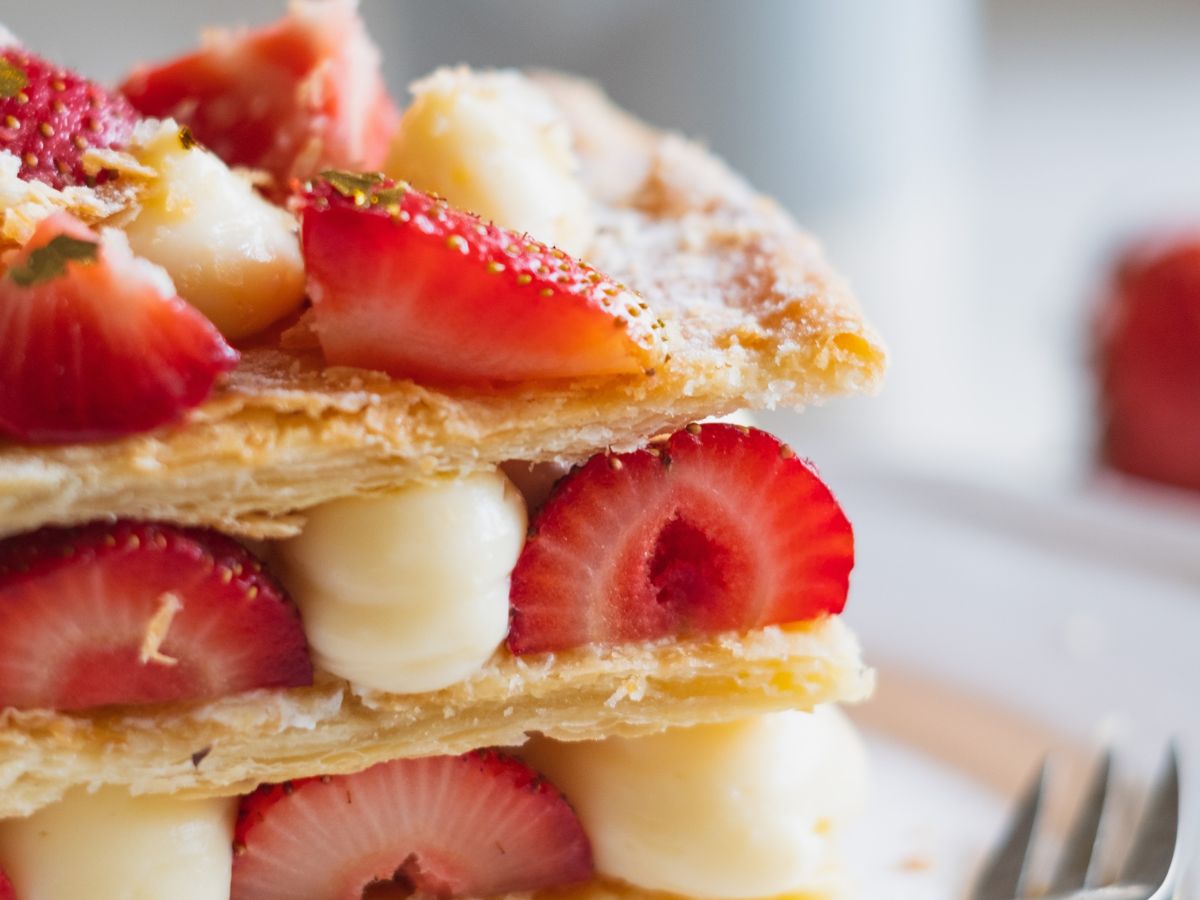French cuisine and French Pastry making are considered to be both highly skilled art forms that have been popular throughout generations.
France is famous for its delectable pastries, so whether you’re planning a vacation or just want to know what to watch out for locally, read our guide to all the best.
FRENCH PASTRIES
French pastries are both rich and indulgent, but beautiful and whimsical. These crisp, flaky, and pillowy marvels have grabbed the imagination of culinary enthusiasts all over the world.
CANNELE
This small crisp, caramelized brown cake is prepared with flour and egg yolks. In addition it has a custard-like center with hints of rum and vanilla.
It comes from the Bordeaux region and has a recognizable cylindrical form. Cannele is cooked in fluted copper molds according to the traditional recipe; which was allegedly created in the 17th century by nuns.
CHOQUETTE
This typical sweet French pastry is created using choux dough and sugar with a custard or mousse filling. The chouquette is particularly hard to get right. The pastry relies on steam to rise so can easily deflate while still warm. Therefore it should be allowed to cool gently in the oven ito cook in the residual heat. Choquettes, loosely translated small bits of choux are they are oftne consumed in France as an afternoon snack. Its creation is credited to the Italian cooks who travelled with Catherine de Medici.
ECLAIR
This long choux dough bun is filled with cream and usually covered with a chocolate frosting. Other fillings can include chestnut puree, custard and other fruit-flavored fillings. Éclair is French means flash; maybe referring to the frosting’s shine. It’s history dates back to the 19th century, when it was initially known by the name petite duchesse. Some culinary historians believe that leading French chef Marie-Antoine Carême may have invented this.
KOUIGN AMANN
This multi-layered buttery pastry is created using methods similar to those used to make croissants. However the major difference is its thick layer of sugar (inside and on top) and its golden caramelized crust.
The pastry originates from the French town of Douarnenez, which was well-known for its butter manufacturing. The name is from Breton and means butter cake.
According to legend, patissier Yves-Rene Scordia accidentally created the cake in the 19th century. He had run out of sweets so experimented with thin layers of bread dough covered in sugar.
MACAROON
A delicious meringue-based biscuit is prepared from egg whites, icing sugar, and ground almonds. It is characteristically French, however popular legend has it that Chefs of Catherine de Medici’s first introduced this delicious biscuit; when she married Henry II of France.
However, another source claims that two nuns from Nancymade macarons famous during the French Revolutionary War. The Maison des Soeurs Macaron in Nancy is reported to follow the same centuries-old recipe. Bakeries Saint-Emilion and Ladurée made the macaroon wrold famous. Now you can now find them in any high end food halls, tea palaces and foodie establishments across the globe.
MADELEINE
This buttery, light, and soft sponge cake, which is made with eggs, flour, sugar, and butter is a favorite tea cake in French cafés. The term “madeleine” may have been coined by Madeleine Paulmier, a cook from the 18th century, or by Madeleine; a traveler who brought the recipe back after her journey. Some claim that the chef Avice was the one who created this unique shell-shaped dessert.
MILLE-FEUILLE – THE KING
Mille Feuille in French means a thousand leaves and that is due to this pastry’s layering.
This pastry is made up of three layers of puff pastry alternated with two layers of pastry cream and topped with icing sugar. Although it appears straightforward in execution, a true specialist is needed to produce an airy, flaky, and crisp vanilla slice.
Other mille feuille varieties incorporate whipped cream, fruits, custard, or chocolate glaze; much like the Italian Napoleon that is filled with almond cream.
Le Cuisinier François, a cookbook published in 1651 by chef François Pierre de la Varenne, had the first mille feuille recipe. In the 19th century, renowned pastry chef Adolphe Seugnot is also credited with creating the mille feuille.
PAN AU CHOCOLATE
Pan au chocolate, meaning “chocolate bread” in French is a breakfast and bakery staple all across thw world.
It was originally created with a brioche foundation but over time has been developed to employ the same buttery, flaky dough as a croissant. It initially appeared in the early nineteenth century and is also known as chocolatine in the south-west of France.
PROFITEROLE
This filled French choux pastry ball usually filled with whipped cream, sometime custard and on occasions; ice cream. It is covered with icing sugar, chocolate or sometimes caramel.
It is been claimed to have been brought to France by de Medici’s retinue of Italian chefs. Choux pastry was devised by Italian chef Panterelli, but his original recipe altered over time. French patissier Jean Avice transformed the dough into choux buns.
In the 18th century, chef Antoine Carême decided to fill the choux with a cream filling; culminating in the profiterole as we know it today. He also designed the profiterole tower, or croquembouche, which is the most popular wedding cake in France.
RELIGIUESE
Religiuese is regarded as one of the most well-known pastry desserts in France. The pastry developed in the 19th century by Italian pastry master Frascati in Paris, means nun.
This dersert is made up of two choux buns stacked on top of one another to resemble a plump nun. Both the top and bottom circles of the cake are filled with cream or custard; with the top circular being bigger and fatter.

